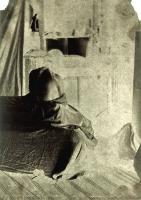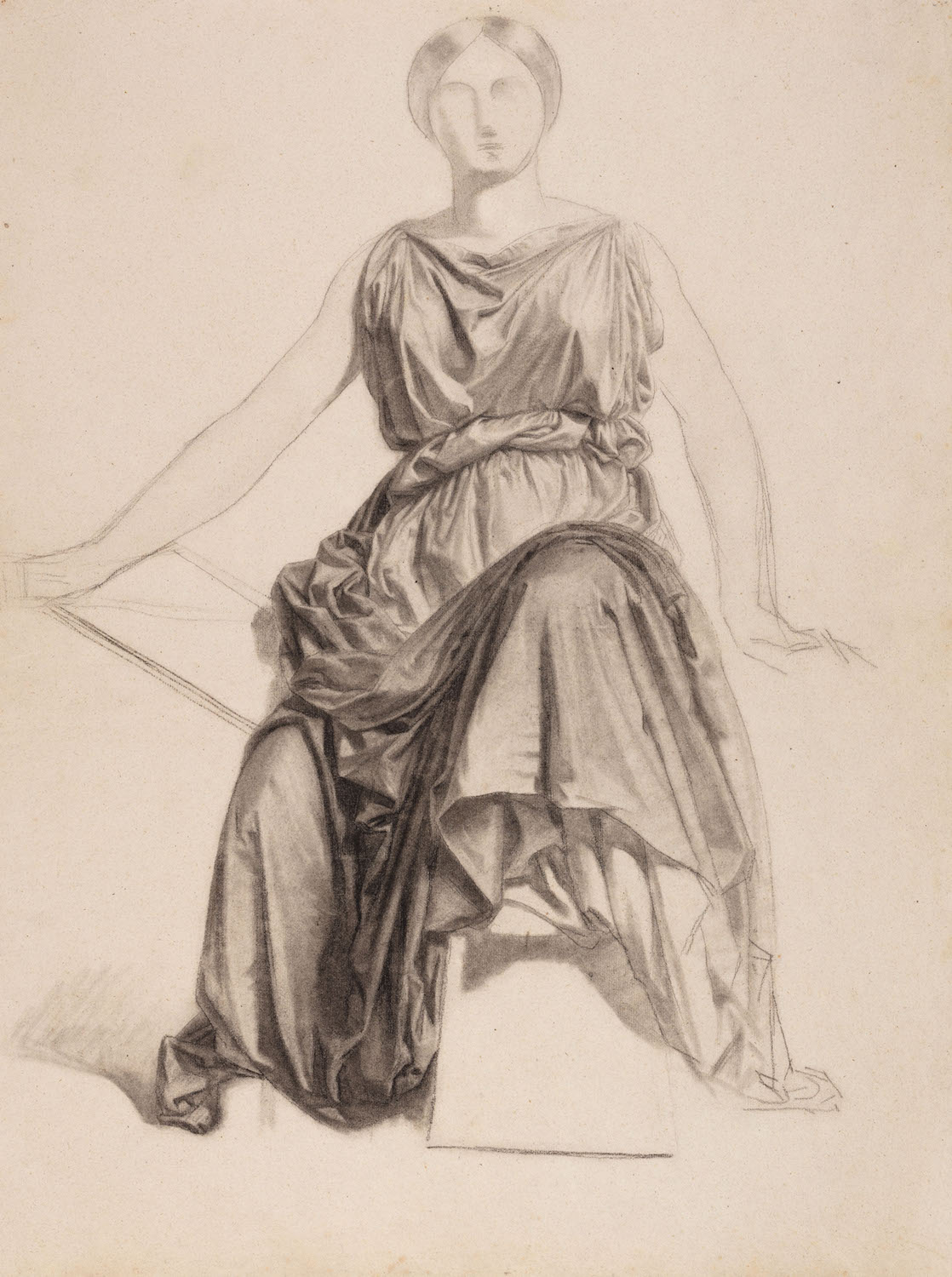
Still Life
Most sources indicate that Charles Nègre was born in Grasse, France on May 9, 1820. His grandfather came to Grasse from Milan in 1778, where his family name was known as Negri. The family was in the perfume and confectionery business in Grasse.
He began his career in the arts at only 17 years old. In 1837, Nègre took drawing classes in Aix-en-Provence, and from 1839, he began to study painting in Paris under the direction of Paul Delaroche, Drolling (Vintage Works has examples of his drawings from the Drolling studio), and finally Ingres, before establishing his own studio at 21 Quai Bourbon on the Île Saint-Louis. Delaroche encouraged use of photography among his student for research for painting. Out of all the students of Delaroche who took up photography, Negre was by far the most gifted at painting and continued to paint while practicing photography. Nègre was admitted to the l'Ecole des beaux-arts in 1841 but was unsuccessful in the contests for the Prix de Rome in 1845. He exhibited paintings in various Salons until 1853.
In about 1844 Nègre learned the practice of making daguerreotypes at a demonstration at the Institute de France, and in about 1848 he began experimenting with paper photography processes. His rare early studies included some nudes, which were very likely studies for the tableaux paintings he would present to the Salons in 1850-51. Gustave Le Gray and Roger Fenton were fellow students, and it is thought by some that Le Gray taught Nègre photography--at least the waxed paper negative process. He certainly taught Nègre's friend, Henri Le Secq. As a photographer Nègre sought to capture moments in time, well before the invention of instant photography. Nègre pursued this revolutionary approach to photography with images such as those he took of walking chimneysweepers and busy market places--all full of bustling energy and movement.

Paper Negative of a Female Nude Model
Nègre became a founding member of the Société Héliographique as well as the Société Française de Photographie. Like his good friend and fellow photographer, Henri Le Secq, Nègre often showed a predisposition to photographing architectural views. In 1852, acting independently from the official Mission Héliographique project, Nègre embarked on his own photographic survey of his native Midi. Within a year, he had made nearly 200 negatives of its scenery, towns, industries and architecture. The interesting shapes in his 1852 photographs of buildings in Grasse and other areas in the Midi have caused them to be seen as a precursor to art photography. However, the attempted publication of a subscription series in 1854 quickly foundered, and very few copies of "Le Midi de la France, sites et monuments historiques photographies par Charles Nègre, peintre" were published. The publication was meant to be comprised of a total of 74 or more plates. Unfortunately, less than 10 of these were ever included.
Nègre's most prolific period of photographing using the waxed paper negative was from 1849-1855 during which time he developed a strong friendship with Le Secq. In the beginning of the1850s his waxed paper negatives included portraits, as well as genre scenes and architectural studies. His paintings often bear striking resemblance to some of these photographs, including those of his famous pifferari series. From about late 1853 Nègre began using wet-plate collodion and albumen on glass negatives, which he used for the commissions 'Portraits de Rachel'. He also used the wet-plate process in 1859, when he was commissioned by Empress Eugénie to photograph the newly established Imperial Asylum de Vincennes, a hospital for disabled workingmen.
Nègre had thought to capitalize on his new relationship with the Emperor and Empress, so he proposed a project to publish a pictorial history of art to the French Emperor in 1858. The history was to be illustrated using Nègre's proprietary heliogravure printing process that he had just developed. That proposal was not accepted, nor was another for a publication on Paris and its history, which he suggested to the Prefect of Paris in August that year. To encourage him though, the head of the Beaux Arts department, Monsieur de Mercey, commissioned him to do a series of prints of the statues and views in the Tuileries gardens. Nègre began photographing in June 1859, producing 30 photographs, and sending the prints for approval by the Beaux Arts directors, but unfortunately his sponsor, Monsieur de Mercey fell ill and died in 1860, and his successor did not continue the project.
But the process with which he was most absorbed from 1854 onward was his own invention, the héliogravure. Nègre was one of the earliest practitioners. Following Nicéphore Nièpce and Nièpce de St. Victor, he developed the process he called héliogravure, which translated a light-sensitive photograph to a permanent ink print. Héliogravure should not to be confused with the photogravure process commonly used today, which was invented by Karl Wenzel Klic (1841-1926) and combines aquatint with a photographic negative.
Nègre was very familiar with etching processes even before taking up the camera; an 1844 etched portrait of Ingres by him survives. In 1854, Nègre published the first reproduction of a small experimental héliogravure within text in the journal La Lumière. Nègre submitted photogravures to the 1855 Universal Exhibition in Paris. Upon viewing them, one critic declared that the "the important question of engraving through the action of light was finally resolved." This was even before the announcement of the Duc de Luyne's competition for reproducing photographs.
Not long after this, at the request of the architect Jean-Baptiste Lassus (1807-1857), Nègre produced a series of large architectural studies and details of Chartres Cathedral, which was under renovation. He reproduced the mid-tones with higher quality than any before him; and his huge gravure prints of the cathedral, which were made just a few years later, are among the largest and most important early photogravures.
Malcolm Daniel has described Nègre's process as consisting of the following steps: "He placed a photographic negative on a steel plate covered with a thin coating of bitumen of Judea (or sometimes gelatin bichromate, which Talbot substituted for bitumen of Judea beginning in 1852); exposed the plate to light through the negative, rendering the coating insoluble wherever it was struck by light; and cleaned the plate (with oil of lavender or water, depending on the coating), baring the surface of the metal plate wherever the coating had been protected by the dark portions of the negative. Had the plate been etched at this point, the image would have appeared as a negative, but instead, Nègre electroplated it with gold; the gold covered those parts where the metal plate was unprotected, partially covered the portions where the coating remained in part, and covered the portions still protected by the insoluble coating only in a lacy network that, like a dusting of rosin, provided a texture to hold the ink and render the mid-tones and dark areas." In 1867 Nègre was awarded a medal for his heliogravures at the second Paris Exposition Universelle.
Although ultimately losing the Duc de Luynes competition for reproducing photographs mechanically, the duke himself thought highly of Nègre's process and awarded him the contract to produce heliogravures based on Louis Vignes' photographs of the duke's trip to Lebanon and Palestine in 1864. Vignes took collodion or albumen on glass and waxed paper negative to record key places. Charles Nègre used Vignes' prints to make printing plates with his newly discovered heliogravure process, which were then used to produce the important and very rare volume, "d'Exploration a la Mer Morte, 1871-1874." It was one of Nègre's last major projects.
In 1863, he returned to southern France, where he worked as a drawing professor in Nice, and then two years later, he opened a photographic studio. He closed the studio in 1878, returning to his birthplace of Grasse, where he died on January 16, 1880.
Exhibited and Sold By
Contemporary Works / Vintage Works, Ltd.
258 Inverness Circle
Chalfont, Pennsylvania 18914 USA
Contact Alex Novak and Marthe Smith
Email info@vintageworks.net
Phone +1-215-518-6962
Call for an Appointment














Share This